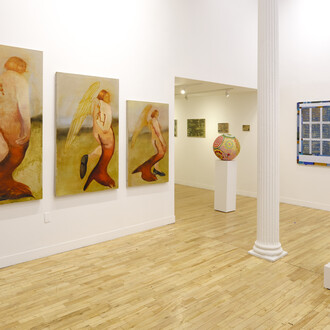As the centerpiece of the transformed fourth floor, the Gallery of Tiffany Lamps features 100 illuminated Tiffany lamps from our spectacular collection, displayed within a dramatically lit jewel-like space. Regarded as one of the world’s largest and most encyclopedic, the Museum’s Tiffany Lamp collection includes multiple examples of the Dragonfly shade, a unique Dogwood floor lamp (ca. 1900–06), a Wisteria table lamp (ca. 1901), and a rare, elaborate Cobweb shade on a Narcissus mosaic base (ca. 1902), among many others.
The hidden history behind the lamps offers a fascinating look at the contributions of women in the creation of this art. Louis C. Tiffany (1848–1933) was the artistic genius behind Tiffany Studios. However, he was not the exclusive designer of its lamps, windows, and luxury objects: Clara Driscoll (1861–1944), head of the Women’s Glass Cutting Department from 1892 to 1909, has recently been revealed as the designer of many of the firm’s leaded glass shades. Driscoll and her staff, self-styled the “Tiffany Girls,” labored in anonymity but were well compensated. Driscoll’s weekly salary of $35 was on par with that of Tiffany’s male designers, a reflection of his regard for her abilities. The lamps in this exhibition reflect the prodigious talent of designers and artisans who worked in anonymity to fulfill Tiffany’s aesthetic vision.
Interactive elements in the gallery include a hands-on “Design-a-Lamp” experience and a diorama that illustrates the rise of electrification. Kiosks share personal stories of the individual Tiffany Girls, including dramatic readings from Clara Driscoll’s letters as well as sources of their design inspiration and details on the manufacturing process.
















